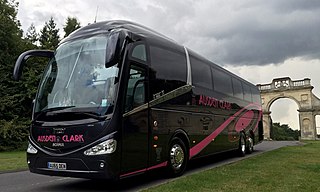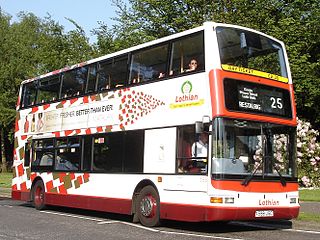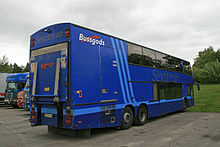
A coach is a type of bus built for longer-distance service, in contrast to transit buses that are typically used within a single metropolitan region. Often used for touring, intercity, and international bus service, coaches are also used for private charter for various purposes. Coaches are also related and fall under a specific category/type of RVs.

Kenworth Truck Company is an American truck manufacturer. Founded in 1923 as the successor to Gersix Motor Company, Kenworth specializes in production of heavy-duty and medium-duty commercial vehicles. Headquartered in the Seattle suburb of Kirkland, Washington, Kenworth has been a wholly owned subsidiary of PACCAR since 1945, operating alongside sister company Peterbilt Motors.

An articulated bus, also referred to as a slinky bus, bendy bus, tandem bus, vestibule bus, stretch bus, or an accordion bus, is an articulated vehicle, typically a motor bus or trolleybus, used in public transportation. It is usually a single-decker, and comprises two or more rigid sections linked by a pivoting joint (articulation) enclosed by protective bellows inside and outside and a cover plate on the floor. This allows a longer legal length than rigid-bodied buses, and hence a higher passenger capacity (94–120), while still allowing the bus to maneuver adequately.

The Volvo B9TL is a low-floor double-decker bus built by Volvo from 2002 until 2018. It superseded the Volvo Super Olympian and the Volvo B7TL. The 2-axle version has been superseded by the Volvo B5TL in 2014 and the 3-axle version has been superseded by the Volvo B8L in 2018.

A low-floor bus is a bus or trolleybus that has no steps between the ground and the floor of the bus at one or more entrances, and low floor for part or all of the passenger cabin. A bus with a partial low floor may also be referred to as a low-entry bus or seldom a flat-floor bus in some locations.

The Volvo B7L is a fully low floor single-decker bus, double-decker bus and articulated bus chassis with a rear engine mounted vertically on the left of the rear overhang. It was built as a replacement for the Volvo B10L, and the Volvo Olympian, used as both a single-decker bus and a double-decker bus chassis largely in Continental Europe. The Volvo B7L was superseded by the Volvo B9L in 2006.

Van Hool NV is a Belgian coachbuilder and manufacturer of buses, coaches, trolleybuses, and trailers.

A midibus is a classification of single-decker minibuses which are generally larger than a traditional minibus but smaller than a full-size single decker and can be anywhere between 8 metres and 11 metres long. While used in many parts of the world, the midibus is perhaps most common in the United Kingdom, where operators have found them more economical, and to have a sufficient number of seats compared to full size single-decker buses.

The Volvo B12BLE is a low-entry city and suburban bus chassis launched in 2001 with a rear-mounted transverse engine. It superseded the Volvo B10BLE and is used as a base for single-decker buses in Europe and Australia.

The Volvo Ailsa B55 was a front-engined double-decker bus chassis manufactured in Scotland by Ailsa, Volvo's British subsidiary in which it owned 75%, from 1974 until 1985.

The Volvo B10M is a mid-engined city bus and coach chassis manufactured by Volvo between 1978 and 2003. It succeeded the B58 and was equipped with the same 9.6-litre horizontally mounted Volvo diesel engine mounted under the floor behind the front axle. An articulated version under the model name Volvo B10MA was also offered, as was a semi-integral version known as the C10M, with the engine in the middle of the chassis.

The Leyland Atlantean is a predominantly double-decker bus chassis manufactured by Leyland Motors between 1958 and 1986. Only 17 Atlantean chassis were bodied as single deck from new.

A bi-articulated bus or double-articulated bus and sometimes train-bus, tram-bus, trackless tram or double bendy bus is a type of high-capacity articulated bus with an extra axle and a second articulation joint, as well as extended length. Bi-articulated buses tend to be employed in high-frequency core routes or bus rapid transit schemes rather than in conventional bus routes.

A multi-axle bus is a bus or coach that has more than the conventional two axles, usually three, or more rarely, four. Extra axles are usually added for legal axle load restriction reasons, or to accommodate different vehicle designs such as articulation, or rarely, to implement trailer buses.

Bus manufacturing, a sector of the automotive industry, manufactures buses and coaches.

The Crown Supercoach is a bus that was constructed and marketed by Crown Coach Corporation from 1948 to 1991. While most examples were sold as yellow school buses, the Supercoach formed the basis for motorcoaches and other specialty vehicles using the same body and chassis. While technically available outside of the West Coast, nearly all Crown school buses were sold in Washington state, Oregon and California.

Lothian Buses is the largest provider of bus services in and around Edinburgh, the capital city of Scotland. It is entirely municipally owned, being 91% owned by the City of Edinburgh Council, with the remainder owned by Midlothian, East Lothian and West Lothian councils. Lothian Buses plc is registered in Annandale Street, Edinburgh as company number SC096849.

The Leyland Royal Tiger Worldmaster, sometimes simply known as the Leyland Worldmaster, was a mid-underfloor-engined single-decker bus or single-decker coach chassis manufactured by Leyland between 1954 and 1979.

The Volvo 9700 is a range of coaches manufactured by Volvo. It was introduced in 2001 as a replacement for the Carrus Star and Vector/Regal models. There are three main models in different heights; 9700S, 9700H and 9700HD. The 9700S is available only in the Nordic countries. In addition there is the stripped down 9500 and the 9900 with theater seating. The coaches come in a variety of lengths up to 15 metres, depending on models and markets. Volvo 9700 is currently sold in most of Europe and North America. In 2015, the Volvo 9800 was launched as a replacement for the 9700 in the Mexican market, followed by the double-decker 9800DD in March 2018.

The Volvo 8900 is a single-decker city bus and intercity bus, first introduced in 2010 as a cross-breed successor to both the aluminium body 8500 and the stainless steel body 8700, taking advantage of both techniques. It is available both with 860 mm step-entrance floor and as the low-entry Volvo 8900LE.































